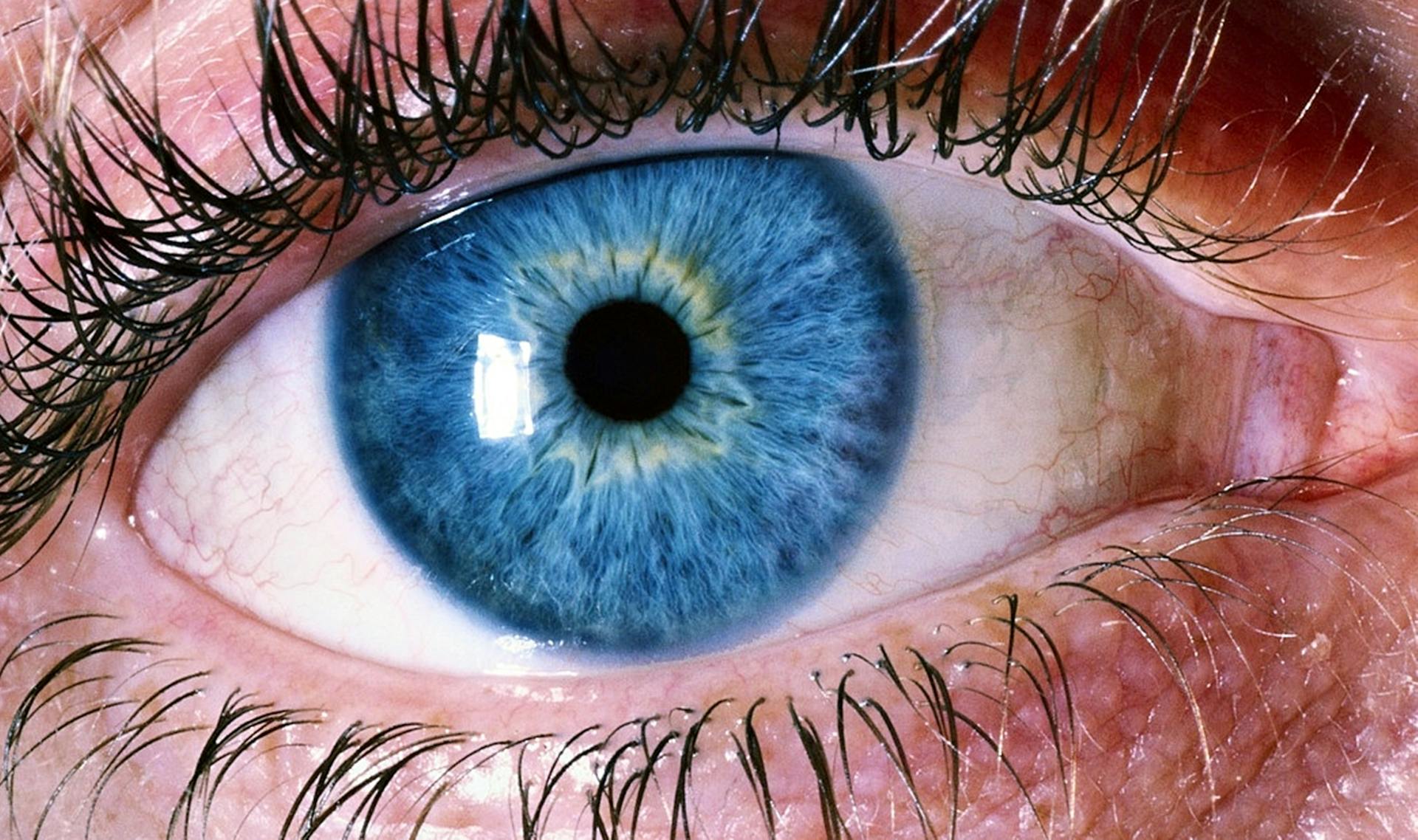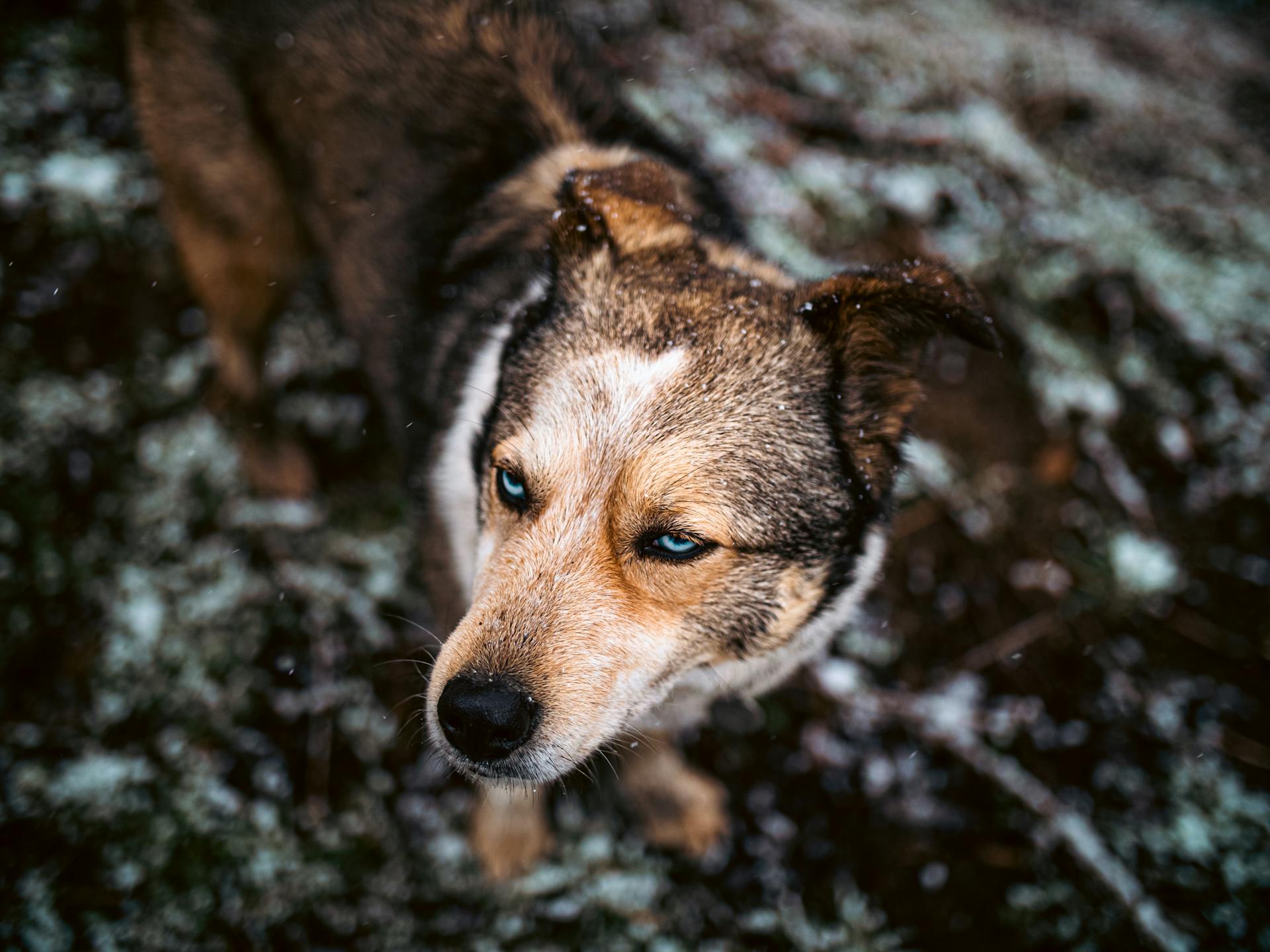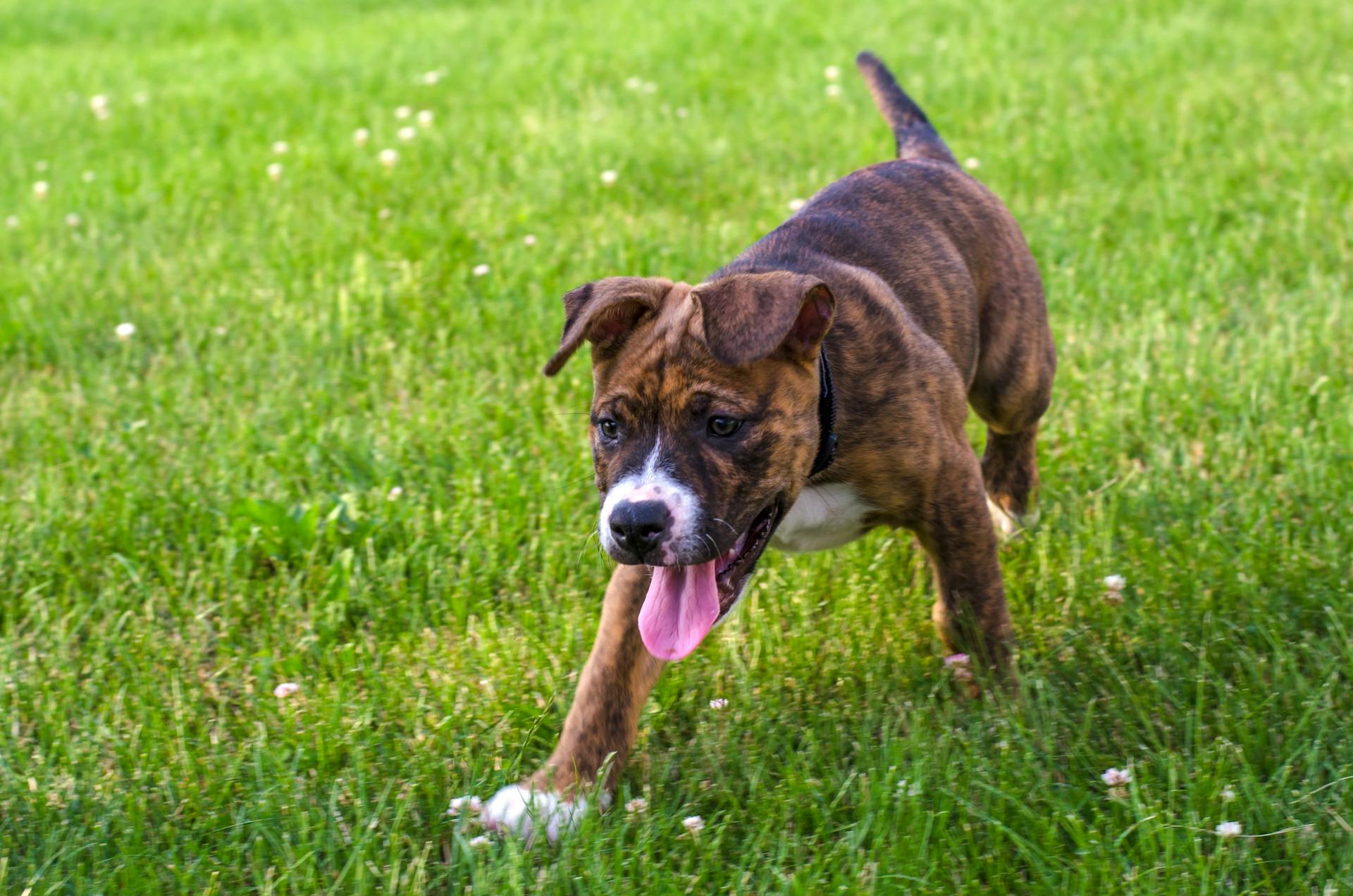
Blue-eyed dogs are prone to certain health issues due to their genetic makeup. A genetic trait that causes the blue color in their eyes can also lead to sensitivity to light.
Some blue-eyed dogs may experience eye problems, such as photophobia or blindness, due to the way their eyes absorb and process light.
The risk of deafness is also higher in blue-eyed dogs, particularly those with a specific genetic variation that affects the development of the inner ear.
A unique perspective: Dog Names for Blue Eyes
Blue-Eyed Dog Health Problems
Blue-eyed dogs can be a stunning sight, but it's essential to know that their eye color can sometimes be a sign of underlying health issues. Discharge from the eyes, red eyes, squinting, and cloudiness of the eyes are common signs of many eye problems, and they should be assessed by a veterinarian.
If your dog's eye color changes suddenly, it's crucial to consult with a vet as soon as possible. Color changes within the eyes can indicate injury, uveitis, glaucoma, clotting problems, cataracts, problems in the retina, the optic nerve, or corneal degeneration.
Check this out: Liver Colored Brittany Spaniel
Some breeds, like Dalmatians, may have a higher risk of deafness if they have partial or sectoral heterochromia. Puppies will often have light bluish eyes at birth, but as they grow, their adult eye color will develop around 7 weeks of age.
The Merle gene, which affects eye color, can also lead to developmental defects in the eye or eyes. This gene can be responsible for a range of eye colors, from pale blue to green to amber, and can impact the front or back part of the eye, or a combination of both.
The following breeds are known to have the Merle gene and may be at risk for eye problems:
- Australian Shepherd
- Rough and Smooth Collies
- Shetland Sheepdog
- American Foxhound
- Catahoula Leopard Dog
Blue eyes in dogs are rare and captivating, but it's essential to remember that they're not due to a blue pigment – it's actually a lack of melanin that scatters light and makes the eyes appear blue.
Eye Problems
Eye problems can be a serious issue for dogs, especially those with blue eyes. Corneal ulcers, for example, are painful scratches or injuries on the surface of the cornea, and can be caused by an injury or infection, or result from inflammation of the cornea due to chronic dry eye.
Dogs with "buggy" eyes, like brachycephalic breeds, are especially prone to corneal ulcers. Treatment involves giving your dog an antibiotic eye drop and using an Elizabethan collar to prevent your dog from rubbing their eye, causing further damage.
Some eye problems can be caused by inherited traits, such as the Merle gene, which can lead to eye abnormalities in Australian Shepherds. Dogs with two copies of the Merle gene (mm) will be mainly white in color, and may experience different degrees of congenital hearing loss.
Here are some common signs of eye problems in dogs:
- Yellow, green, or red drainage from the eyes
- Swelling, crusting, and hair loss on the eyelids
- Very red and swollen conjunctiva and whites of the eyes
- Discharge from the eyes, red eyes, squinting, and cloudiness of the eyes
- Green or yellow discharge from the eye
- Rubbing the eye because it is painful or itchy
Corneal Ulcers
Corneal ulcers are a serious eye problem that can cause a dog a lot of pain. They're essentially a scratch or injury on the surface of the cornea, the clear part of the eye.
A dog with a corneal ulcer will often squint the eye closed and may rub at it, which can make the problem worse. This is because the ulcer is very painful, and rubbing it can cause further damage.
You might like: Dog Problem Training
Corneal ulcers can be caused by an injury, infection, or inflammation of the cornea due to chronic dry eye. Dogs with "buggy" eyes, like brachycephalic breeds, are especially prone to this.
If you suspect your dog has a corneal ulcer, it's essential to seek treatment from the vet as soon as possible to help make your dog more comfortable. Treatment involves giving your dog an antibiotic eye drop and using an Elizabethan collar to prevent your dog from rubbing their eye.
Here are some common signs of corneal ulcers:
- Cloudiness in the front of the eye
- Green, yellow, or clear discharge
- Squinting or holding the eye closed
- Rubbing at the eye
If left untreated, a corneal ulcer can lead to serious complications, including the eye rupturing or scarring of the cornea, which will limit the dog's vision. Some dogs may even require surgery to heal the ulcer.
Causes
Eye problems in dogs can be caused by a variety of factors, and it's essential to know what to look out for. Discharge from the eyes, red eyes, squinting, and cloudiness of the eyes are common signs of many eye problems.
Glaucoma is a serious eye condition that can cause increased pressure in the eye, leading to pain, redness, and vision loss. If left untreated, glaucoma can result in the loss of the affected eye.
Retinal issues can also cause blindness in dogs, and this is often due to inherited diseases such as those seen in Irish Setters, Briards, and the Papillon. High blood pressure, distemper virus, fungal infections, and other conditions can also damage the retina.
Some eye problems are inherited, and the Merle gene is one example. Dogs with two copies of the Merle gene (mm) are considered homozygous, or double merle, and may experience eye abnormalities.
Worth a look: Dog Sudden Hearing Loss
Cataracts
Cataracts can cause a dog's central vision to appear cloudy due to a loss of lens transparency, and can affect one or both eyes.
Cataracts can be caused by diabetes in dogs, as excess glucose causes the lens to swell and potentially rupture, leading to uveitis, a severe inflammation in the eye.
Aging is another common cause of cataracts in dogs, as the lens can become cloudy and affect vision over time.
In some cases, cataracts can form due to inflammation or infection inside the eye, which can lead to significant vision loss and even blindness.
Some dogs may only experience minor vision problems due to cataracts, while others may lose significant vision and become blind, depending on the size and severity of the cataract.
Dog Eyelid Growth/Lump
If you notice a growth or lump on your dog's eyelid, it's essential to have it checked out by your vet as soon as possible.
Eyelid tumors are quite common in middle-aged to older dogs.
Benign tumors at the edge of the eyelid, called meibomian cysts, are usually not a problem unless they're large enough to rub on the surface of the eye.
Surgery may be required to remove a meibomian cyst if it becomes inflamed or large enough to injure your dog's eye.
Malignant tumors, such as mast cell tumors, squamous cell carcinoma, and melanoma, can also occur on the eyelid and will require surgical removal.
It's crucial to have any lumps on your dog's eyes checked out by your vet.
Eye Symptoms
Eye symptoms in blue-eyed dogs can be a cause for concern. Dogs with the Merle gene, especially those with an excessive white coat, can experience eye abnormalities such as a small eye (microphthalmia), a pupil that's off-center (corectopia), and cataracts.
Dogs with watery eyes, also known as epiphora, may have a blockage in the nasolacrimal duct or allergies as the cause. If your dog's eyes are red or the skin on their face is irritated, it's essential to have them assessed by a veterinarian.
Some common eye symptoms in dogs include bulging eyes, which can be a sign of glaucoma or a tumor, and swollen eyes, which can be caused by infection, allergies, or injury. If you notice any of these symptoms, it's crucial to have your dog evaluated by a veterinarian as soon as possible.
Here are some potential causes of cloudy eyes in dogs:
- Corneal ulcers
- Chronic dry eye
- Cornea inflammation due to infection
- Eyelid diseases that cause irritation to the cornea, such as entropion or eyelid tumors
- Glaucoma and tumors in the eyes
Squinting in dogs can be a sign of eye pain, which can be caused by various conditions, including allergies, infections, and glaucoma. If you notice your dog squinting, it's essential to have them evaluated by a veterinarian to determine the underlying cause.
Suggestion: Dog Squinting
Watery
Watery eyes in dogs can be a sign of a few different things. If your dog has watery eyes but doesn't show any signs of redness or irritation, it's likely not a cause for concern.
However, if their eyes are red or the skin on their face is irritated, it's a good idea to have them checked out by a vet.
A blockage in the nasolacrimal duct can cause excess drainage, but allergies are the most common cause of sudden epiphora.
Some breeds, like Poodles and Spaniels, are more prone to watery eyes due to their anatomy.
If your dog's eyes are watery but otherwise healthy, you can try cleaning their eyes with a damp cloth to help remove any debris.
Here are some common causes of watery eyes in dogs:
- Blockage in the nasolacrimal duct
- Allergies
Bulging
Bulging eyes in dogs can be a concerning symptom, but understanding the possible causes can help you identify the issue.
A bulging eye can be a sign of glaucoma, a condition where the pressure in the eye increases.
Glaucoma can cause the eye to become larger than normal, which is a clear indication of the problem.
In some cases, a tumor or a shallow eye socket can push the eye out of its normal position, making it appear bulged.
This is often seen in brachycephalic breeds like Pugs, whose shallow eye sockets can cause their eyes to protrude.
If you notice sudden bulging eyes in your dog, it's essential to have them assessed by a veterinarian as soon as possible.
Here are the two main reasons for bulging eyes in dogs:
- The eye is larger than normal, which is a sign of glaucoma.
- The eye is pushed out of the eye socket, often due to a tumor or shallow eye socket.
Swollen
Swollen eyes in dogs can be a sign of infection, allergies, or injury.
If your dog's eyes are swollen, it's essential to have them assessed by a veterinarian to determine the cause and appropriate treatment.
Corneal injuries can cause swelling in your dog's eyes, and it's crucial to get them checked by a vet as soon as possible.
Entropion, a condition where the eyelid rolls inward, can also lead to skin infections and swelling in your dog's eyes.
Swelling of your dog's eyes should never be ignored, as it can be associated with serious underlying conditions that require prompt veterinary attention.
You might enjoy: English Bulldog Swollen Eye
Squinting in
Squinting in dogs is a sign of eye pain, and it's a common symptom of many eye diseases, including allergies and infections.
Squinting can also be associated with painful eyelid afflictions, such as entropion and skin infections.
Eye diseases like glaucoma and chronic dry eye can cause squinting in dogs, making it harder for them to see and feel comfortable.
Squinting is a red flag that your dog needs to see a vet to rule out any underlying eye problems.
A fresh viewpoint: Common Diseases in Cocker Spaniels
Symptoms
Squinting in dogs is a sign of eye pain, often associated with eye diseases like allergy, infection, and glaucoma.
Squinting can also be a sign of painful eyelid afflictions, such as entropion, tumors, or skin infections.
A dog's eye can be impacted by the Merle gene anomaly, leading to symptoms like a small eye (microphthalmia) and blindness.
Dogs with the Merle gene can experience various eye abnormalities, including a diluted or dappled coat, varied iris color, and cataracts.

Here are some common eye symptoms in dogs:
- Squinting
- Cloudy eyes
- Swollen eyes
- Cataracts
Eye symptoms should be assessed by a veterinarian as soon as possible to determine the cause and appropriate treatment.
Prompt treatment can prevent permanent damage to the eye and make your dog more comfortable.
A swollen eye can be caused by infection, allergies, or injury, making it essential to seek veterinary attention.
The Merle gene anomaly can cause blindness, which is a severe consequence of this genetic condition.
Eye Issues Diagnosis and Treatment
If your dog's eye doesn't look normal, they could have an eye problem. Discharge from the eyes, red eyes, squinting, and cloudiness of the eyes are common signs.
Any abnormalities in your dog's eye can be diagnosed by a veterinarian. They may recommend a veterinary ophthalmologist to look for structural abnormalities.
Diseases of the retina in dogs can cause blindness, and some causes include high blood pressure, distemper virus, and fungal infections. If you notice your dog acting blind, have them seen by a veterinarian as soon as possible.
In some cases, eye problems can be treated, but the type of treatment depends on the condition. Dogs with the Merle gene may have eye abnormalities, including thinning of the iris, cataracts, and scleral ectasia.
Here are some common signs of eye problems in dogs:
- Discharge from the eyes
- Red eyes
- Squinting
- Cloudiness of the eyes
Diagnosis
A veterinarian will conduct a physical examination of your dog to check for any abnormalities that may indicate the presence of the Merle gene.
The examination can be done as early as six weeks of age.
Your veterinarian may recommend a visit to a veterinary ophthalmologist to look for structural abnormalities in your dog's eyes.
Structural abnormalities can include thinning of the iris, an off-center pupil, iris coloboma, and the lens of the eye may be out of place.
Persistent pupillary membranes, or PPMs, can be seen, which are strands or sheets of tissue that start from the iris and connect to another part of the iris, lens, or cornea.

Cataracts can occur as a result of the Merle gene, and can be either focal or complete.
The sclera, the white of the eye, can be unusually thin, leading to a staphyloma, which is a bulge that can be present in the front or back of the eye.
The examination will determine whether there are eye abnormalities present in your dog and how severe they are.
Treatment
Treatment for dogs with the Merle gene is dependent on the conditions that have resulted from the inheritance of the gene. Some abnormalities have no treatment options.
Dogs with the Merle gene should not be bred, even if they're only displaying a mild form of the condition, as they can still pass the gene on to their offspring. Their offspring can experience the condition in a more severe form.
Treatment for the Merle eye anomaly may be possible, but it's essential to attend follow-up appointments as recommended by your veterinarian to monitor changes in your dog's condition.
Frequently Asked Questions
What does it mean if a dog has blue eyes?
Dogs with blue eyes may have corneal edema, a condition caused by excess water in the cornea, often accompanied by discharge or tearing
Do dogs with blue eyes have hearing problems?
Dogs with blue eyes may be more prone to hearing problems in certain breeds, but blue eyes alone do not necessarily indicate deafness. Research suggests that specific breeds, such as Dalmatians and Bull Terriers, may be more likely to experience hearing issues.
Are blue-eyed dogs more sensitive to the sun?
Yes, dogs with light-colored eyes, including blue eyes, are more susceptible to sun damage and eye irritation due to UV rays. This increased sensitivity requires extra sun protection measures to prevent discomfort and potential eye problems.
Sources
- https://todaysveterinarypractice.com/ophthalmology/small-animal-corneal-edema/
- https://www.petmd.com/dog/general-health/evr_dg_eye_problems_in_dogs
- https://wagwalking.com/condition/merle-eye-anomaly
- https://www.wisconsindesignerdoodles.com/stokeshire-doodle-puppy-blog/blue-eyed-doodles
- https://www.dogster.com/dog-health-care/dogs-with-different-colored-eyes-heterochromia-in-dogs
Featured Images: pexels.com


